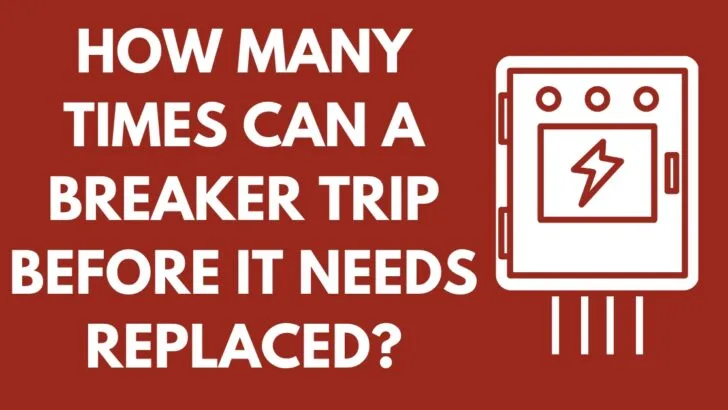A breaker can trip around 50 times before it needs to be replaced. If your breaker is tripping repeatedly, it’s possible that it needs to be replaced, or it may be that the demand on the breaker is too great.
Older breakers may start tripping more frequently, but there are a few things to consider before replacing them. This article will discuss this and more, so stick around.
Why Is My Breaker Tripping?
A breaker will often trip due to an overload when an appliance or several appliances on the same circuit draw more power than it can safely handle. If you can isolate which items are causing the breaker to trip, this might solve the problem.
If a kettle and a microwave share the same circuit and are both in use simultaneously, then the power that both appliances are likely to draw together will likely cause the breaker to trip. A kettle and a microwave oven require a high wattage and should be on separate circuits.
Plugging in too many appliances is never a good idea and should be avoided wherever possible.
Why Is My Breaker Tripping When There Is Just One Appliance Running?
When a breaker trips under the load requirement from a single appliance, it’s most likely the appliance at fault. Many modern appliances are double insulated to protect users from short circuits or other electrical problems within the item.
Here are the scenarios you should determine before replacing your breaker:
- If you continue to use a faulty appliance on the circuit, it can become damaged beyond repair, and the breaker could overheat and melt, shortening its life.
- If you can confirm the appliance is at fault, then the best thing to do would be to remove the appliance and either take it to a repair shop or replace it with a new one.
- Should the appliance not be at fault, there’s the possibility of a problem with either the circuit or the breaker.
How Many Times Can My Breaker Trip Before I Need To Replace It?
Under test conditions in a manufacturer’s laboratory, a breaker is subjected to testing equivalent to up to six times the rating. The test requires the breaker to safely survive up to 50 short circuits and continue to provide protection (source).
However, circumstances dictate whether the fault tripping your breaker is liable to shorten the working life of that component faster than laboratory expectations.
So 50 trips over 25 years might be acceptable, or once every six months.
If it tripped five to ten times daily, that limit will be reached much sooner. I would certainly want to take action either to isolate the offending appliance or discover what else on the circuit is causing the issue.
What if I Don’t Replace My Breaker?
If you don’t replace a faulty, old, or degraded breaker, it will continue to fail until it stops working. A breaker is a safety valve to stop a problem from escalating and becoming dangerous.
A faulty breaker could cause a fire in the electric panel if it gets too hot, and leaving a tripping breaker unchecked could mean an issue with the circuit being neglected. It might be time to consider upgrading the whole system in older houses where the breaker board is 25 to 30 years old.
Can I Just Install a Bigger Breaker?
Installing a bigger breaker isn’t recommended, as the circuit protected by the existing breaker is only rated for the level of the breaker already fitted. If you need more power in the location affected by this issue, you should consider upgrading the entire circuit.
If you install a 30 amp breaker on a 20 amp circuit, this will either transfer the problem to somewhere else on the circuit, causing a short circuit in the cable, outlet, or appliance, or it will continue to trip. Don’t waste your time!
I had two electric convection heaters installed by a young electrician who failed to read the wattage correctly when he fitted the breaker. They were running at twice the power draw he expected, and the breaker almost melted in the panel.
On this occasion, upgrading the breaker to the correct rating was correct, as the cables and conduit were the right dimensions. If in doubt, always check with a qualified electrician, and don’t be afraid to ask questions when they are on the job. Most tradesmen I have worked with enjoy sharing their knowledge.
How Much Can a Breaker Take?
In the real world, for example, a standard 15 Amp breaker should only be expected to handle up to 80% of its capacity or 1,600 Watts, which goes for all breakers. As soon as the wattage gets close to the maximum a breaker can take, the likelihood that it will trip increases.
If you’re working on a home renovation project, you might use the circuit to power a tool, but tripping multiple times daily will harm a breaker.
After a while, it will tend to heat up, degrading the breaker’s effectiveness.
A breaker is regulated by a small electromagnet that releases the spring-loaded contacts when a certain level of electrical current passes through it. The higher the current, the more likely the electromagnet will be damaged, meaning it will work less well.
The best-case scenario is it will become more sensitive, tripping more frequently.
Conclusion
When a breaker trips, something’s not working correctly in the electrical system in the house. Consider the following:
- Are you asking too much of a particular circuit?
- Is there an issue with the wiring within the circuit?
- Did the breaker come to the end of its working life?
Check your appliances first, as that is the easiest, most obvious, and most likely way to solve the issue. After that, if replacing the breaker with the same size component still doesn’t work, then it’s time to call an electrical engineer or consider replacing the circuit.

Simon Kellow is a master carpenter with over thirty-five years of experience in carrying out home renovations while running construction projects large and small. When he’s not in the office or fixing something in the workshop you can find him enjoying the great outdoors with his family.

